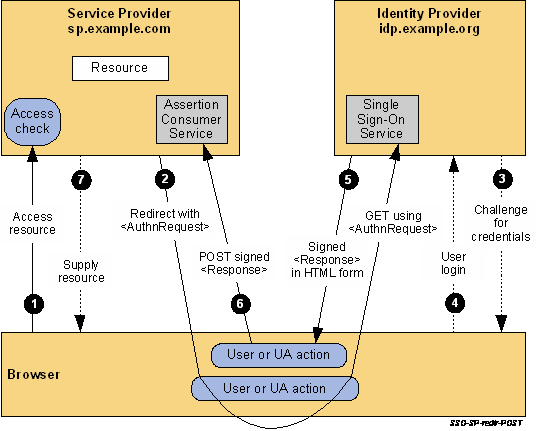This first example describes an SP-initiated SSO exchange. In such an exchange, the user attempts to access a resource on the SP, sp.example.com. However they do not have a current logon session on this site and their federated identity is managed by their IdP, idp.example.org. They are sent to the IdP to log on and the IdP provides a SAML web SSO assertion for the user's federated identity back to the SP. For this specific use case, the HTTP Redirect Binding is used to deliver the SAML <AuthnRequest> message to the IdP and the HTTP POST Binding is used to return the SAML <Response> message containing the assertion to the SP. Figure 12 illustrates the message flow. The processing is as follows:
<samlp:AuthnRequest xmlns:samlp="urn:oasis:names:tc:SAML:2.0:protocol" xmlns:saml="urn:oasis:names:tc:SAML:2.0:assertion" ID="identifier_1" Version="2.0" IssueInstant="2004-12-05T09:21:59Z" AssertionConsumerServiceIndex="1"> <saml:Issuer>https://sp.example.com/SAML2</saml:Issuer> <samlp:NameIDPolicy AllowCreate="true" Format="urn:oasis:names:tc:SAML:2.0:nameid-format:transient"/> </samlp:AuthnRequest> The query string is encoded using the DEFLATE encoding. The browser processes the redirect response and issues an HTTP GET request to the IdP's Single Sign-On Service with the SAMLRequest query parameter. The local state information (or a reference to it) is also included in the HTTP response encoded in a RelayState query string parameter. https://idp.example.org/SAML2/SSO/Redirect?SAMLRequest=request&RelayState=token
<form method="post" action="https://sp.example.com/SAML2/SSO/POST" ...> <input type="hidden" name="SAMLResponse" value="response" /> <input type="hidden" name="RelayState" value="token" /> ... <input type="submit" value="Submit" /> </form> The value of the SAMLResponse parameter is the base64 encoding of the following <samlp:Response> element: <samlp:Response xmlns:samlp="urn:oasis:names:tc:SAML:2.0:protocol" xmlns:saml="urn:oasis:names:tc:SAML:2.0:assertion" ID="identifier_2" InResponseTo="identifier_1" Version="2.0" IssueInstant="2004-12-05T09:22:05Z" Destination="https://sp.example.com/SAML2/SSO/POST"> <saml:Issuer>https://idp.example.org/SAML2</saml:Issuer> <samlp:Status> <samlp:StatusCode Value="urn:oasis:names:tc:SAML:2.0:status:Success"/> </samlp:Status> <saml:Assertion xmlns:saml="urn:oasis:names:tc:SAML:2.0:assertion" ID="identifier_3" Version="2.0" IssueInstant="2004-12-05T09:22:05Z"> <saml:Issuer>https://idp.example.org/SAML2</saml:Issuer> <!-- a POSTed assertion MUST be signed --> <ds:Signature xmlns:ds="http://www.w3.org/2000/09/xmldsig#">...</ds:Signature> <saml:Subject> <saml:NameID Format="urn:oasis:names:tc:SAML:2.0:nameid-format:transient"> 3f7b3dcf-1674-4ecd-92c8-1544f346baf8 </saml:NameID> <saml:SubjectConfirmation Method="urn:oasis:names:tc:SAML:2.0:cm:bearer"> <saml:SubjectConfirmationData InResponseTo="identifier_1" Recipient="https://sp.example.com/SAML2/SSO/POST" NotOnOrAfter="2004-12-05T09:27:05Z"/> </saml:SubjectConfirmation> </saml:Subject> <saml:Conditions NotBefore="2004-12-05T09:17:05Z" NotOnOrAfter="2004-12-05T09:27:05Z"> <saml:AudienceRestriction> <saml:Audience>https://sp.example.com/SAML2</saml:Audience> </saml:AudienceRestriction> </saml:Conditions> <saml:AuthnStatement AuthnInstant="2004-12-05T09:22:00Z" SessionIndex="identifier_3"> <saml:AuthnContext> <saml:AuthnContextClassRef> urn:oasis:names:tc:SAML:2.0:ac:classes:PasswordProtectedTransport </saml:AuthnContextClassRef> </saml:AuthnContext> </saml:AuthnStatement> </saml:Assertion> </samlp:Response>
POST /SAML2/SSO/POST HTTP/1.1 Host: sp.example.com Content-Type: application/x-www-form-urlencoded Content-Length: nnn SAMLResponse=response&RelayState=token where the values of the SAMLResponse and RelayState parameters are taken from the HTML form of Step 5. The service provider's Assertion Consumer Service obtains the <Response> message from the HTML FORM for processing. The digital signature on the SAML assertion must first be validated and then the assertion contents are processed in order to create a local logon security context for the user at the SP. Once this completes, the SP retrieves the local state information indicated by the RelayState data to recall the originally-requested resource URL. It then sends an HTTP redirect response to the browser directing it to access the originally requested resource (not shown).
|
